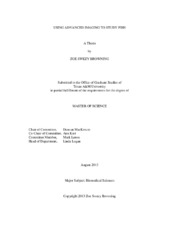| dc.description.abstract | Although mammals are the most commonly utilized laboratory animal, laboratory animal medicine continually seeks to replace them with animals of lower phylogenic classification. Fish are becoming increasingly important as investigators seek alternative animal models for research. Fish can provide an economical and feasible alternative to typical mammalian models; moreover, many fish, which have comparatively short life spans, can easily reproduce in the laboratory. One key area of animal health research in which fish have been underutilized is the field of advanced imaging. Although many images of fish have been captured through the use of computed tomography (CT), radiography, and ultrasonography, these images have been primarily utilized for anatomical study. In addition, fish have never before been studied with positron emission tomography/ computed tomography (PET/CT). My objectives were to determine if these imaging techniques can be used to obtain physiological information from fish, therefore making it more likely that fish can be utilized as replacement animals using these new imaging techniques (CT, PET/CT). I performed two different types of studies to assess the potential application of advanced imaging techniques to fish. In the first experiment, microCT was used to characterize otolith deformity in vitamin C deficient captive-raised red drum and relate the deformity to behavioral and physiological changes. I found that the normal and abnormal fish had statistically significant differences in behavior, cortisol levels, and otolith volume and density. MicroCT assessment of abnormal fish revealed operculum abnormalities, malocclusions, and several types of otolith malformations. Therefore, the affected fish had not only an abnormal skeletal appearance but also significantly abnormal behavior and cortisol responses. In the second experiment, fluorodeoxyglucose-positron emission tomography/ computed tomography (FDG-PET/CT) was used to quantify glucose uptake in select organs prior to carcinogenesis studies in fish. The quantified glucose uptake was compared to published data on humans, mice, and dogs. Rapid, quantifiable glucose uptake was demonstrated, particularly in brain, kidneys, and liver in all imaged fish species. Glucose uptake in the major organ systems of fish was closer to that in humans than uptake in mice or dogs, indicating that fish may serve as an effective alternative animal model for tumor studies using this technology. Other applications for this technique in fish may include metabolism studies and screening for environmental carcinogenesis. I found that both microCT and PET/CT imaging provided useful and meaningful results. In addition, the use of non-invasive scanning allows for re-use of fish, thus reducing the number of animal models used in experiments. These experiments suggest that fish will be good replacement models for mammals using these advanced imaging techniques. | en |


